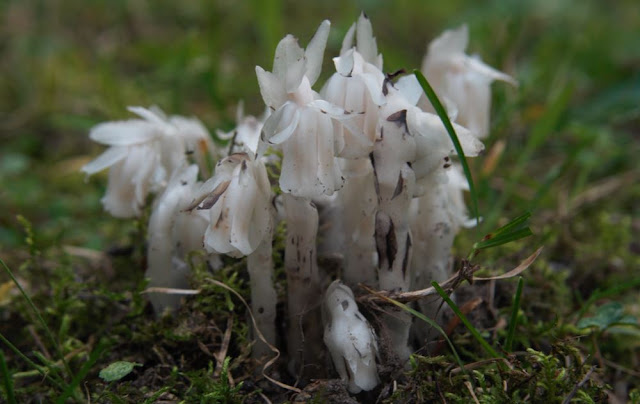This forest native has no chloroplasts and can't photosynthesize. How does it survive? By cheating.
 |
| Ghost Plant, Monotropa uniflora L. |
Ghost Plant, also called Wax Plant, is well named. It looks like something fashioned, if not out of ether, then out of a chunk of paraffin and an active imagination.
Resembling a fungus more than a flowering plant, its pale, waxy stems and scaly leaves have no chloroplasts. They were lost somewhere along the plant’s evolutionary pathway, yet it manages to survive without being able to make sugars by photosynthesis. At first Ghost Plant was thought to be saprophytic, absorbing nutrients from decaying organic matter in its surroundings. That’s what fungi do, and it made sense that this plant, so similar in appearance, would do the same.
 |
| Each stem bears a nodding flower. |
From Partner to Parasite
Scientists then found that its roots, like those of most plants, don’t work alone. They are covered with and invaded by fungi, beneficial partners that reach farther into the soil to collect and transport nutrients, especially nitrogen and phosphorus, back to the plant.
These associations between fungi and roots, called mycorrhizae (MY-co-RY-zee, literally “fungus roots”), typically benefit both partners. The plant receives nutrients gathered by the fungus, and the fungus receives photosynthate made by the plant. It’s a textbook example of mutualism, a type of symbiosis in which both organisms gain something from their relationship.
Ancestors of Ghost Plant might have started out that way, with both the plant and the fungus sharing something with the other. Somewhere along the line, though, the relationship changed. When Ghost Plant lost its chloroplasts, it could no longer give photosynthate to its fungal partner. The two-way relationship became one-way, and Ghost Plant behaved more like a parasite.
As a result, some of those fungal partners probably dropped off. With nothing to feed them, the fungi don't benefit from the relationship, and their association with Ghost Plant likely dwindled from a diverse many to a select few that either best met the plant’s needs or that failed to detect the ruse and avoid becoming hosts (1).
Tapping the Connection
Ghost Plant’s mycorrhizae are now associated only
with fungi in the genus Russula, a group of mushroom-forming decomposers
found all over the world (2). Russula also forms mycorrhizae
with other plants -- green plants, plants that photosynthesize and send
sugars to the fungus and then to Ghost Plant, if it’s joined to the same
network.
Like tapping into a phone conversation, Ghost Plant takes some of what’s exchanged – in this case, sugars and nutrients – to support itself, without giving anything in return. It’s an adaptation that helps the plant survive in the deep shade of forest interiors. No need to grow tall or early or to develop leaves that can tolerate shade. Just plug into the web of connections between plants and fungi and take what’s needed.
Some scientists simply call the plant a parasite, either on the fungus or on the green plants connected to it. Others, citing the plant’s pickpocket habit, choose a more colorful term: Cheater.
Description and Range
Ghost Plant emerges and flowers in
late summer. Each hooked stems bears a single flower at its tip. After flowering,
the stems straighten and develop capsules full of tiny seeds. For more help
with identification, see the Minnesota
Wildflowers page for this species.
 |
| After flowering, the stems straighten and the flowers later develop capsules (right) with many seeds. |
In Minnesota, Ghost Plant is mostly a northern species, but it’s also found in scattered counties in the south. It also grows in most of Wisconsin and generally in forests throughout the U.S. and Canada. According to Nature Serve Explorer and the Global Biodiversity Information Facility, Ghost Plant is also found in Central America, South America, Europe and Asia.
1) Merckx, V., Bidartondo, M.I., Hynson, N.A. 2009.
Myco-heterotrophy: when fungi host plants. Annals of Botany 104 (7): 1255-1261.
doi: 10.1093/aob/mcp235
2) Massicotte, H.B., Melville, L.H., and Peterson, R.L. 2005.
Structural features of mycorrhizal associations in two members of the
Monotropoideae, Monotropa uniflora and Pterospora andromedea.
Mycorrhiza 15: 101-110. DOI: 10.1007/s00572-004-0305-6
Additional References
Dance, A. 2017. Inner workings: Special relationship between
fungi and plants may have spurred changes to ancient climate. Proceedings of
the National Academy of Sciences USA 114(46): 12089-12091. Accessed online on
9/12/22 at https://www.ncbi.nlm.nih.gov/pmc/articles/PMC5699097/.
Van der Heijden, M.G.A., Martin,
F.M., Selosse, M.-A., Sanders, I.R. 2015. Mycorrhizal ecology and evolution:
the past the present, and the future. New Phytologist Foundation 205 (4):
1406-1423. https://doi.org/10.1111/nph.13288.



